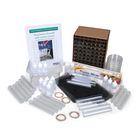AP® Environmental Science: Population Growth Curve Analysis
For the following growth curves, identify the type of growth (linear, logistic, or exponential) for each chart and write a paragraph explaining exactly how the population is changing over time. Refer to the slope (growth rate) and the shape of the curve to explain your answers.
1.

2.

3.

4.

Try this Carolina kit:
Students use the common aquatic plant duckweed for population growth studies. Population data is graphed and the type of growth (exponential or logistic) is determined. Students use the population curve to determine carrying capacity and to estimate biotic potential.
Answers
- Linear. The slope of the line is the number of individuals added per unit of time. The carrying capacity is the value at the horizontal line.
- Exponential growth at the beginning and then a population crash.
- Exponential growth at the beginning and then cyclical growth and die-offs. Possibly the introduction of a new species followed by a traditional predator-prey relationship.
- Logistic growth with carrying capacity shown.
AP® is a trademark registered and/or owned by the College Board®, which was not involved in the production of, and does not endorse, these products.



